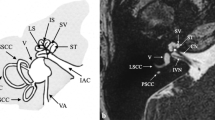Abstract
To correlate symptoms of deviated nasal septum (DNS) and chronic rhinosinusitis with the findings of nasal endoscopy and computed tomographic (CT) imaging. To evaluate the influence of degree of septal angle deviation on the severity of lateral nasal wall abnormalities. A prospective study was conducted on 67 patients with clinical evidence of DNS and chronic sinusitis attending ENT OPD between January 2012 and September 2013. All these patients underwent nasal endoscopy and CT scan PNS coronal sections. Direction and degree of DNS was recorded. Range of sinus mucosal thickening on CT scan films was also recorded. Chronic sinusitis is common in the age group between 21 and 40 years (50.74 %) with male preponderance (55.22 %), chief symptoms being nasal obstruction (86.56 %), headache (73.13 %) and nasal discharge (52.23 %). Left sided DNS is more common (64.17 %). Most of the patients have moderate DNS, i.e. 6°–10° (56.7 %), followed by severe (22.4 %) and then mild (20.9 %). DNS results in compensatory structural changes in the turbinates and/or lateral nasal wall which causes ostiomeatal complex (OMC) obstruction resulting in sinusitis. Contralateral concha bullosa and ethmoid bulla prominence was noted. Maxillary sinus is most commonly affected sinus (73.13 %). Patients with increasing septal angles were associated with a higher incidence of maxillary sinus mucosal changes (p < 0.05). Present study reemphasized the concept that septal deviation causes obstruction at OMC which results in an increased incidence and severity of bilateral chronic sinus disease.



Similar content being viewed by others
References
Atkas D, Kalcioglu MT, Kutlu R, Ozturan O, Oncel S (2003) The relationship between the concha bullosa, nasal septal deviation and sinusitis. Rhinology 41:103–106
Bolger WE, Butzin CA, Parsons DS (1991) Paranasal sinus bony anatomic variations and mucosal abnormalities: CT analysis for endoscopic sinus surgery. Laryngoscope 101:56–64
Buyukertan M, Keklikoglu N, Kokten G (2002) A morphometric consideration of nasal septal deviations by people with paranasal complaints; a computed tomography study. Rhinology 41:21–24
Calhoun KH, Waggenspack GA, Simpson CB, Hokanson JA, Bailey BJ (1991) CT evaluation of the paranasal sinuses in symptomatic and asymptomatic populations. Otolaryngol Head Neck Surg 104(4):480–483
Davis WE, Templer J, Parsons DS (1996) Anatomy of the paranasal sinuses. Otolaryngol Clin North Am 29(1):57–91
de Araújo Neto SA, Martins PDSL, Souza AS, Baracat ECE, Nanni L 2006 The role of ostiomeatal complex anatomical variants in chronic rhinosinusitis. Radiologia Brasileira 39:3. São Paulo May/June 2006. ISSN 0100-3984
Elahi MM, Frenkiel S, Fageeh N (1997) Paraseptal structural changes and chronic sinus disease in relation to the deviated septum. J Otolaryngol 26(4):236–240
Keles B, Ozturk K, Unaldi D, Arbag H, Ozer B (2010) Is there any relationship between nasal septal deviation and concha bullosa. Eur J Gen Med 7(4):359–364
Kennedy DW, Zinreich SJ, Rosenbaum AE, Johns ME (1985) Functional endoscopic sinus surgery—theory & diagnostic evaluation. Arch Otolaryngol 111:576–582
Laine FJ, Smoker WR (1992) The ostiomeatal unit and endoscopic surgery: anatomy, variations, and imaging findings in inflammatory diseases. AJR Am J Roentgenol 159:849–857
Mamatha H, Shamasunder NM, Bharathi MB, Prasanna LC (2010) Variations of ostiomeatal complex and its applied anatomy: a CT scan study. Indian J Sci Technol 3:8 ISSN 0974-6846
Milczuk HA, Dalley RW, Wessbacher FW, Richardson MA (1993) Nasal and PNS anomalies in children with chronic sinusitis. Laryngoscope 103(3):247–252
Som PM (1985) CT of paranasal sinuses. Neuro Radiol 27:189–201
Stammberger H, Hawke M (1993) Essentials of endoscopic sinus surgery, 1st edn. Mosby, St. Louis, MO, p 43
Stammberger H, Wolf G (1988) Headaches and sinus diseases : the endoscopic approach. Ann Otol Rhinol Laryngol 97(Suppl 134):3–23
Yousem DM, Kennedy DW, Rosenberg S (1991) Ostiomeatal complex risk factors for sinusitis: CT evaluation. J Otolaryngol 20(6):419–424
Zinreich SJ (1990) Paranasal sinus imaging. Otolaryngol Head Neck Surg 103(5):863–868
Conflict of interest
The authors declare that they have no conflict of interest.
Author information
Authors and Affiliations
Corresponding author
Rights and permissions
About this article
Cite this article
Poorey, V.K., Gupta, N. Endoscopic and Computed Tomographic Evaluation of Influence of Nasal Septal Deviation on Lateral Wall of Nose and Its Relation to Sinus Diseases. Indian J Otolaryngol Head Neck Surg 66, 330–335 (2014). https://doi.org/10.1007/s12070-014-0726-2
Received:
Accepted:
Published:
Issue Date:
DOI: https://doi.org/10.1007/s12070-014-0726-2




